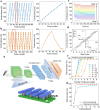Reconfigurable Compute-In-Memory on Field-Programmable Ferroelectric Diodes
- PMID: 36121208
- PMCID: PMC11388457
- DOI: 10.1021/acs.nanolett.2c03169
Reconfigurable Compute-In-Memory on Field-Programmable Ferroelectric Diodes
Abstract
The deluge of sensors and data generating devices has driven a paradigm shift in modern computing from arithmetic-logic centric to data-centric processing. Data-centric processing require innovations at the device level to enable novel compute-in-memory (CIM) operations. A key challenge in the construction of CIM architectures is the conflicting trade-off between the performance and their flexibility for various essential data operations. Here, we present a transistor-free CIM architecture that permits storage, search, and neural network operations on sub-50 nm thick Aluminum Scandium Nitride ferroelectric diodes (FeDs). Our circuit designs and devices can be directly integrated on top of Silicon microprocessors in a scalable process. By leveraging the field-programmability, nonvolatility, and nonlinearity of FeDs, search operations are demonstrated with a cell footprint <0.12 μm2 when projected onto 45 nm node technology. We further demonstrate neural network operations with 4-bit operation using FeDs. Our results highlight FeDs as candidates for efficient and multifunctional CIM platforms.
Keywords: Compute in memory; ferroelectric diode; neural network; nonvolatile; parallel search; reconfigurable architecture; ternary content-addressable memory.
Conflict of interest statement
The authors declare the following competing financial interest(s): D.J., X.L., R.O., and E.A.S. have a provisional patent filed based on this work. The authors declare no other competing interests.
Figures




References
-
- Krizhevsky A.; Sutskever I.; Hinton G. E. Imagenet classification with deep convolutional neural networks. Communications of the ACM 2017, 60 (6), 84–90. 10.1145/3065386. - DOI
-
- He K.; Zhang X.; Ren S.; Sun J. In Deep residual learning for image recognition, Proceedings of the IEEE conference on computer vision and pattern recognition, 2016; pp 770–778.
-
- Sze V.; Chen Y.-H.; Yang T.-J.; Emer J. S. Efficient processing of deep neural networks: A tutorial and survey. Proceedings of the IEEE 2017, 105 (12), 2295–2329. 10.1109/JPROC.2017.2761740. - DOI
-
- Chen Y.-H.; Krishna T.; Emer J. S.; Sze V. Eyeriss: An energy-efficient reconfigurable accelerator for deep convolutional neural networks. IEEE journal of solid-state circuits 2017, 52 (1), 127–138. 10.1109/JSSC.2016.2616357. - DOI
Publication types
MeSH terms
Substances
LinkOut - more resources
Full Text Sources

